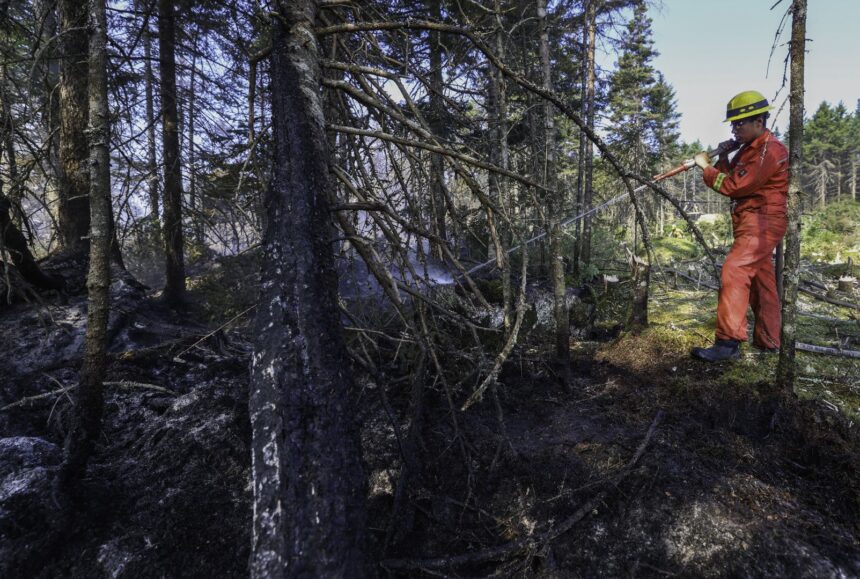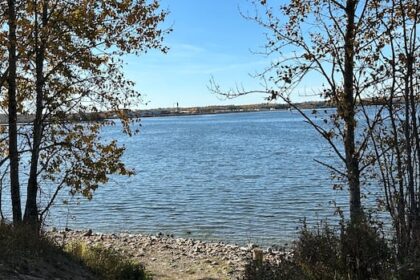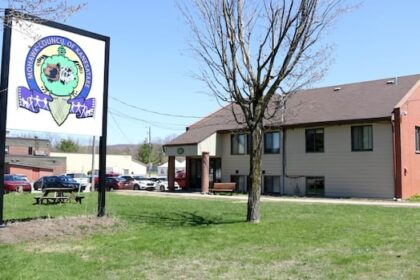Local firefighter Oryan Curry of Annapolis Royal hoses down a hot spot at the Long Lake wildfire. Photo by Province of Nova ScotiaArticle contentUnfavourable weather conditions are hindering firefighting efforts as the Long Lake wildfire has grown to over 1,100 hectares, according to Natural Resources officials on Sunday. “The province continues to be very hot and dry,” said Jim Rudderham, DNR’s director of fleet and forest protection at Sunday’s update. “Today is very low humidity, windy and warm, everything we don’t need for helping us put out fires.” Scott Tingley, Manager of Forest Protection for DNR, said the current status of the wildfire near West Dalhousie remains out of control and growing. “We are expecting the fire to grow today; these are not favourable firefighting conditions,” said Tingley. “Very dry and the wind is predominantly out of the southwest, so it has pushed the fire northeast early this morning.” With the wildfire expected to grow, the DNR officials are closely monitoring its path toward homes on West Dalhousie Rd. Over 100 homes have been evacuated, and a state of local emergency was declared by the Municipality of the County of Annapolis on Saturday. “The last estimate we were getting was within a couple of kilometres of the West Dalhousie Rd., where the evacuation alerts have been in place for a number of days now and where structure protection efforts have been put in place. It’s being monitored quite closely from the air. “We are trying to steer the fire away from values of risk as best we can. Efforts have been made in structure protection. Hose and sprinkler systems have been put in place and are ready to turn on once it is deemed there may be a threat to values at risk.” Tingley added that the team has used heavy equipment to build barriers around other key pieces of infrastructure, such as the community centre. “They are on high alert there, everybody is prepared and ready for what might happen,” said Rudderham. “There were no more evacuations last evening, they were pretty broad to start with. So after this evening, they will reassess to see where the fire may have gone for the day.”THIS CONTENT IS RESERVED FOR SUBSCRIBERS ONLY.Subscribe now to access this story and more:Unlimited access to the website and appExclusive access to premium content, newsletters and podcastsFull access to the e-Edition app, an electronic replica of the print edition that you can share, download and comment onEnjoy insights and behind-the-scenes analysis from our award-winning journalistsSupport local journalists and the next generation of journalistsSUBSCRIBE TO UNLOCK MORE ARTICLES.Subscribe or sign in to your account to continue your reading experience.Unlimited access to the website and appExclusive access to premium content, newsletters and podcastsFull access to the e-Edition app, an electronic replica of the print edition that you can share, download and comment onEnjoy insights and behind-the-scenes analysis from our award-winning journalistsSupport local journalists and the next generation of journalistsRegister to unlock more articles.Create an account or sign in to continue your reading experience.Access additional stories every monthShare your thoughts and join the conversation in our commenting communityGet email updates from your favourite authorsSign In or Create an AccountorArticle contentArticle contentArticle contentArticle content An excavator clears a fire break at the edge of the fire line at the Long Lake wildfire. Photo by Province of Nova ScotiaArticle contentArticle contentArticle contentRESPONSE TEAM GROWINGArticle contentThe firefighting response has grown in numbers as well, with 57 DNR staff, 84 volunteer fire department members, five firefighters from Prince Edward Island, a 20-person crew from Ontario and the return of a 20-crew team from Nova Scotia, which was released from New Brunswick’s wildfire efforts. Two contract helicopters from a company in Halifax and four fixed-wing air tankers from the Northwest Territories are also dropping water on the wildfire. Tingley said the air support won’t put out the fire, but is critical to allowing the ground crews to access the fire. “The helicopters and water bombers are used to slow down the spread of the fire and reduce the intensity,” said Tingley. “The water bombing from the air helps reduce the intensity, so crews on foot and the heavy equipment can get in and do the actual extinguishing of the fire.” Tingley expects to have the fixed-wing bombers at their disposal for the ‘foreseeable future.’ A weather forecast for five millimetres of rain late in the evening and into Monday morning won’t bring much relief for the wildfire, said Rudderham. “We don’t begrudge any rain here, but it’s really not going to do very much,” he said. “We need a few days of nice, steady rain. Remember, with this drought, the ground is so crusty that it’s going to take a good day to break that crust and water to go into the ground. We need protracted rain.”Article contentFIFTEEN ACTIVE WILDFIRESArticle contentDNR said there were no new wildfires reported on Saturday, but there are still 15 active wildfires in the province, with Long Lake being the only one out of control. “Yesterday, we had no new starts, which was wonderful,” said Rudderham. “Our crews are on high alert. We were very lucky we had no new fires yesterday.”Article content
Unfavourable weather conditions hindering Long Lake wildfire response











